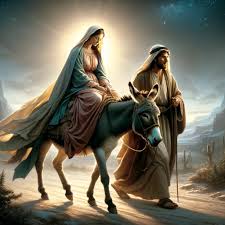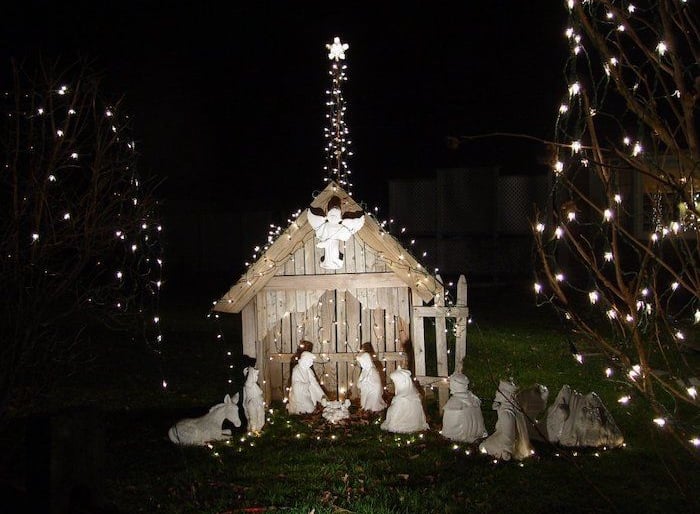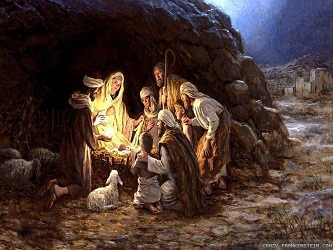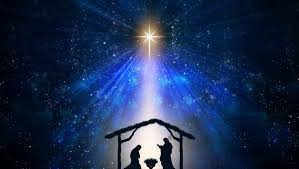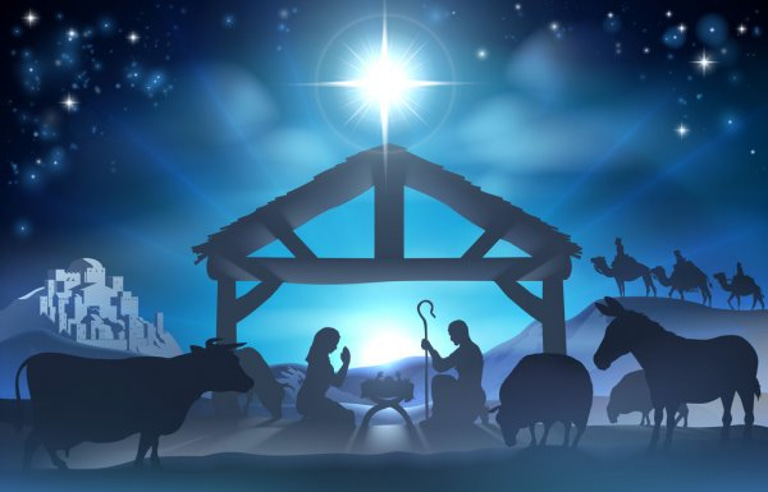What Are the Most Common Myths About the Nativity Story?
Uncover the truth behind the Nativity story. How much is fact? How much is myth? Dive into the details and find out today!
Grace Callahan
12/14/202421 min read


Was there truly a shining star over Bethlehem? Did Mary and Joseph journey alone, and was Jesus born on December 25? By examining the legends and myths of the Nativity alongside historical and biblical facts, we can deepen our understanding of this beloved story. Let’s dive in!
The Origins of Nativity Myths and Legends
The Nativity story has been passed down for over 2,000 years. Before the invention of the printing press, these tales spread orally, often gaining embellishments along the way. The goal wasn’t necessarily accuracy but to convey profound spiritual truths and capture the imagination of the faithful.
Take, for example, the idea of a glowing, serene baby Jesus in the manger. This imagery likely evolved to emphasize His divinity, but a newborn in first-century Judea would’ve been wrapped tightly in cloth to keep warm and calm—a practical, not mystical, detail.
As we unravel these stories, we’ll see how early Christian storytelling shaped the way we celebrate Christmas today.
Was Jesus Born on December 25?
One of the most enduring questions about the Nativity is whether Jesus was actually born on December 25. This date is central to modern Christmas celebrations, but its historical accuracy remains a topic of debate among scholars and theologians. What’s the real story behind this date, and how did it come to symbolize Christ’s birth?
Biblical Silence on the Date
Surprisingly, the Bible doesn’t specify the day or even the time of year Jesus was born. The Gospels of Matthew and Luke, our primary sources for the Nativity story, focus on the events surrounding His birth—Mary and Joseph’s journey, the manger, and the shepherds. But there’s no mention of a calendar date.
Why wouldn’t the early Christians record such an important detail? It’s likely because the exact date wasn’t as significant to them as the meaning of the event itself. Jesus’ birth marked the fulfillment of prophecy and the arrival of the Messiah—timeless truths that transcended the need for a specific date.
When Did Christians Begin Celebrating Christmas?
Early Christians didn’t celebrate Christmas at all. In fact, for the first few centuries, they focused more on commemorating Jesus’ death and resurrection, which were central to their faith.
The first recorded celebration of Christmas on December 25 occurred in the year 336 during the reign of the Roman Emperor Constantine. By the late fourth century, this date had been established as the official celebration of Christ’s birth in the Western Church. But why this date?
December 25 and Pagan Festivals
One of the most widely accepted theories is that December 25 was chosen to coincide with pagan winter solstice festivals. In ancient Rome, the solstice marked the celebration of Saturnalia, a time of feasting, gift-giving, and merriment in honor of the god Saturn. Later, the festival of Sol Invictus (the Unconquered Sun) celebrated the “rebirth” of the sun as the days began to grow longer.
By aligning Christmas with these popular celebrations, early Christian leaders may have sought to “Christianize” pagan traditions, making it easier for converts to embrace their new faith. December 25 became a symbolic date to celebrate Jesus as the “Light of the World” (John 8:12), bringing spiritual illumination during the darkest time of the year.
What Do Historical Clues Tell Us?
Historical and biblical clues suggest Jesus may not have been born in December. Luke’s Gospel provides one important detail: shepherds were “living out in the fields, keeping watch over their flocks by night” (Luke 2:8).
In first-century Judea, shepherds typically kept their flocks outdoors from spring to early autumn. By late December, the weather would have been too cold for this practice. This suggests that Jesus’ birth may have occurred in a warmer season, such as spring or early fall.
Additionally, some biblical scholars point to the timeline of John the Baptist’s conception and birth as a clue. According to Luke, John’s father, Zechariah, served in the temple during the division of Abijah, which corresponds to a specific time in the Jewish calendar. Based on these calculations, some suggest Jesus was born in September or October.
A Symbolic Date with Spiritual Meaning
Despite the historical uncertainties, December 25 carries deep symbolic meaning. The date emphasizes themes of light overcoming darkness—a powerful message that resonates with the Nativity story.
Imagine the world at the time of Jesus’ birth: a weary, chaotic place filled with political oppression and spiritual longing. The arrival of Christ brought hope and salvation, much like the returning sun brings warmth and renewal after the darkest days of winter.
For Christians today, December 25 serves as a reminder that Jesus is the true light of the world, shining brightly in the midst of our struggles and fears.
What Does It Mean for Us?
Does it matter if Jesus wasn’t born on December 25? For many Christians, the answer is no. The exact date pales in comparison to the significance of the event itself. What’s important is the meaning we draw from it—that God humbled Himself to be born among us, offering hope, peace, and redemption.
The celebration of Christmas on December 25 invites us to pause and reflect. Whether or not it’s historically accurate, it’s a time to remember the miracle of Jesus’ birth and the joy it brings to the world.
So, as you gather around your Nativity scene or light a candle this Christmas, let the date remind you of something greater: that Christ’s light shines in the darkness, and the darkness cannot overcome it (John 1:5).
Did Mary and Joseph Travel Alone?
The image of Mary and Joseph traveling alone to Bethlehem has become iconic, often depicted in Nativity plays and Christmas cards. Mary is usually shown riding a donkey, her face serene despite the difficulties of the journey, while Joseph walks protectively beside her. But how accurate is this portrayal?
What Does the Bible Say About Their Journey?
The Gospels, particularly Luke’s account, give us only sparse details about the journey: “Joseph also went up from the town of Nazareth in Galilee to Judea, to Bethlehem the town of David because he belonged to the house and line of David. He went there to register with Mary, who was pledged to be married to him and was expecting a child” (Luke 2:4–5).
Noticeably absent is any mention of a donkey, a solitary journey, or specific hardships along the way. The focus of the Gospel is on the purpose of the trip—fulfilling the census and ultimately God’s divine plan—not the logistics of their travel.
Why Is It Unlikely They Traveled Alone?
In first-century Judea, travel was rarely a solo endeavor, especially for a young couple. Here’s why:
Safety in Numbers
Roads in ancient times were fraught with danger. Bandits and wild animals were a genuine threat, particularly on long, rural stretches. For safety, people often traveled in caravans or groups, sometimes with extended family or neighbors.Cultural Context
Jewish society placed great importance on community and family. As devout Jews, Mary and Joseph would have likely journeyed with others making their way to Bethlehem for the census. Traveling in isolation would have been unusual and, frankly, unsafe.Shared Destination
Since Joseph was returning to his ancestral town for the Roman census, other members of his family or clan might have been making the same trip. It's plausible that the couple joined a group of relatives heading to Bethlehem, creating a sense of shared purpose and support.
Was There Really a Donkey?
Ah, the iconic donkey. It’s such a beloved image that it’s hard to imagine the Nativity story without it. But surprisingly, the Gospels don’t mention a donkey at all.
Why, then, do we associate Mary with riding a donkey? Likely, it’s a practical assumption. The journey from Nazareth to Bethlehem was about 90 miles—a grueling trek, especially for a pregnant woman. While walking would have been the norm for many, a donkey would have provided a more manageable way for Mary to travel.
Even without biblical evidence, the image of Mary riding a donkey is a poignant symbol. It underscores her vulnerability and the humble circumstances of Jesus’ birth.
The Challenges of the Journey
Imagine the journey from Nazareth to Bethlehem:
Terrain and Distance
The route, which spanned about 90 miles, likely took them through hilly, rugged terrain. This wasn’t an easy stroll—it would have required physical stamina and determination, especially for Mary, who was nearing the end of her pregnancy.Weather Conditions
Depending on the season, they might have faced cold nights or blazing sun. The lack of modern comforts like paved roads or rest stops would have made the trip even more arduous.Pregnancy and Fatigue
For Mary, traveling while heavily pregnant would have been exhausting. Imagine the discomfort of bouncing on a donkey or walking for hours on uneven paths. Yet she persevered, a testament to her faith and strength.
Why Does the Image Persist?
The enduring image of Mary and Joseph traveling alone likely arises from artistic and narrative tradition rather than historical fact. Artists and storytellers have long sought to highlight their faith, courage, and humility, and the idea of a solitary journey emphasizes these qualities.
However, imagining them traveling with others doesn’t diminish their story. Instead, it paints a picture of a couple who, though ordinary in many ways, were part of a broader community—and chosen by God for an extraordinary purpose.
What Can We Take Away from Their Journey?
The journey to Bethlehem is more than a historical detail—it’s a reflection of Mary and Joseph’s faith and obedience. Whether they traveled alone or with others, their willingness to face the hardships of the journey reminds us of the sacrifices they made to fulfill God’s plan.
As you reflect on this part of the Nativity story, consider the humanity of Mary and Joseph. Picture their determination as they pressed on toward Bethlehem, their faith in God’s promise guiding them every step of the way. Whether they were surrounded by family or walking quietly side by side, their journey was one of love, trust, and unwavering hope.
And the donkey? Whether it was there or not, let it remind us of the simplicity and humility at the heart of the Christmas story—a story that continues to inspire and guide us today.
The Stable and the Manger: A Humble Setting or a Misunderstanding?
When we think of the Nativity scene, one of the most common images is of Jesus’ birth in a humble stable, surrounded by animals and nestled in a manger. This scene has become iconic in our Christmas celebrations, but is it truly accurate? Was Jesus really born in a stable, or is this part of the story a bit of a misunderstanding?
The Biblical Account and the “Inn”
The Gospel of Luke tells us that Mary and Joseph couldn’t find room at the inn, leading them to place Jesus in a manger (Luke 2:7). But what exactly does "inn" mean, and does it refer to the type of lodging we imagine today?
The Greek word used in the text is kataluma, which is commonly translated as "inn." However, this term more often refers to a guest room in a private home rather than a commercial inn. In fact, the word "inn" in the New Testament is only used in this context, and elsewhere, kataluma refers to the room where people would host guests during their travels.
So, it’s possible that Mary and Joseph didn’t go to an inn at all. They might have sought shelter with relatives or family members in Bethlehem. But, because the town was overcrowded due to the census, there may not have been space available in the guest room. Instead, they could have been given a spot in a lower-level room or part of the house where animals were kept—such as a stable-like area.
Was It a Wooden Stable?
The image of a wooden stable, with hay and animals surrounding the newborn Jesus, is deeply ingrained in Western Christmas traditions. But could that have been the actual setting? The answer, based on the historical and archaeological context, is likely no.
In first-century Bethlehem, homes were often built with a lower level or cave-like spaces used to house animals. These spaces were typically simple, functional areas where livestock could be sheltered from the elements, and it wasn’t uncommon for family members to sleep in the same area. Rather than a freestanding wooden structure, it’s more likely that Jesus was born in a setting similar to these lower rooms or even a cave, which were commonly used for both living and animal shelter.
A Humble Birth in a Humble Place
The idea of a stable in a picturesque rural setting is appealing and has become part of the charm of the Christmas story. However, the actual setting may not have been quite as idyllic as our modern depictions. A humble room where animals were kept is a more probable setting, reflecting the simplicity and humility that marked Jesus’ birth.
The use of a manger, a feeding trough for animals, further underscores the humble nature of His arrival. A manger is typically a basic, rustic object—certainly not the kind of royal crib one might expect for a king. Yet this image highlights the message of the Nativity: that Jesus came not as a wealthy ruler, but as a humble servant, born in modest circumstances to bring salvation to the world.
What Does This Tell Us About Jesus' Birth?
The setting of Jesus' birth is significant, not because of the conditions in which He was born, but because of what they reveal about the nature of His coming. From the very beginning, Jesus was born into poverty, among ordinary people, in a place where the rich and powerful would not have chosen to stay. This was a key part of His mission: to show that God’s love and salvation were available to all, regardless of social status or wealth.
In a world where power and wealth were highly valued, the humble birth of Jesus in a modest setting is a profound statement about His purpose. He came not to be served, but to serve (Mark 10:45). The place of His birth—the humble room or cave where He lay in a manger—perfectly illustrates His mission on earth: to bring light to the world, regardless of earthly power or status.
A Modern Reflection
When we look at our Nativity scenes, we often focus on the warmth and charm of the imagery—the cozy stable, the shepherds in awe, and the bright star overhead. But it's important to remember the deeper message behind the birth of Jesus in such humble surroundings. This wasn’t a story about a royal family being born in a palace but about God choosing to enter the world in the most ordinary way possible.
This humble setting challenges us to reflect on how we see greatness. Are we drawn to the outward trappings of wealth and power, or do we recognize the true worth in humility, service, and love? As we celebrate Christmas, we can remember that Jesus’ humble birth calls us to reflect on the ways we can serve others, live with compassion, and focus on the values that truly matter.
What Does the Manger Mean for Us?
The manger is more than just a piece of wood; it’s a powerful symbol of Jesus’ arrival into the world. His bed was a feeding trough, used to nourish animals, and yet it serves as the cradle for the Savior of the world. It’s a reminder that Jesus came to feed the hungry, to offer spiritual nourishment to all who seek Him.
As we reflect on the Nativity, we are invited to embrace the humility of the manger—embracing simplicity, being open to serving others, and finding true greatness in following the example of Christ. No matter where we are in life, we can all be part of this story by embracing the love and humility that Jesus exemplified from the very moment He entered the world.
In the end, whether Jesus was born in a cave, a stable, or a humble room, the setting doesn’t diminish the significance of His birth. It only magnifies it. Through His humble beginnings, we are reminded that greatness in God’s kingdom is often found in the most unexpected places. And that, my friends, is the true message of Christmas.
How Many Shepherds Were There?
When we think of the Nativity story, we often imagine a small, intimate gathering around the newborn Jesus. Among the familiar figures are the shepherds—humble, awe-struck men who received the good news of Christ’s birth from the angels. But there’s one detail about the shepherds that is often misunderstood: how many were there?
The Bible doesn’t actually specify the number of shepherds who visited Jesus. While we frequently imagine three—possibly because this number corresponds with the three gifts of the Magi—it’s important to note that this is an assumption rather than a biblical fact. So, how did this assumption come to be, and what is the true significance of the shepherds’ role in the Nativity?
The Biblical Account
Let’s turn to the Bible for some clarity. The account of the shepherds visiting Jesus is found in Luke 2:8-20. Here's what we know:
“And there were shepherds living out in the fields nearby, keeping watch over their flocks at night. An angel of the Lord appeared to them, and the glory of the Lord shone around them, and they were terrified. But the angel said to them, ‘Do not be afraid. I bring you good news that will cause great joy for all the people. Today in the town of David a Savior has been born to you; he is the Messiah, the Lord. This will be a sign to you: You will find a baby wrapped in cloths and lying in a manger.’” (Luke 2:8-12)
The angel’s message was then followed by a heavenly host of angels, praising God. Afterward, the shepherds decided to go to Bethlehem to find the newborn child. Luke 2:16 says, “So they hurried off and found Mary and Joseph, and the baby, who was lying in the manger.”
Notice here, Luke doesn’t give us a specific number of shepherds—he simply mentions “shepherds” in the plural. It could have been a group of two or more, but the Bible doesn’t tell us the exact count. The assumption that there were three likely stems from the tradition of the three gifts presented by the Magi, and over time, that number became associated with the shepherds as well.
Why Do We Often Picture Three Shepherds?
The idea that there were three shepherds likely evolved from the early Christian tradition of matching the number of visitors to the newborn Jesus with the number of gifts brought by the wise men (gold, frankincense, and myrrh). In many Nativity scenes, there are often three wise men, and as these scenes grew in popularity, the number of shepherds was similarly assumed to be three.
However, there’s no actual scriptural support for this idea. In fact, in the historical context of first-century Judea, shepherds were typically part of larger groups. The actual number of shepherds could have been far greater than three, as shepherds often traveled in groups to care for their flocks.
The Shepherds’ Role in the Nativity
While the exact number of shepherds may be unknown, their role in the Nativity is undeniably significant. In first-century Jewish society, shepherds were often seen as lower-class, even marginalized. They were considered unclean by the religious elite because they spent much of their time with animals and didn’t have regular access to purification rituals. Many religious people likely looked down on them as outcasts.
Yet, despite their status in society, it was shepherds who were the first to hear the good news of Christ’s birth. The message of the angels wasn’t delivered to kings, priests, or rulers, but to humble, ordinary men working in the fields. This is one of the most striking and profound aspects of the Nativity story.
Imagine the moment these shepherds received the announcement:
“An angel of the Lord appeared to them, and the glory of the Lord shone around them…” (Luke 2:9).
They were filled with awe and fear, but the angel reassured them, giving them the first opportunity to witness the Messiah’s birth. Their response was immediate and faithful—they hurried to Bethlehem, leaving their flocks behind to find the child. When they arrived, they were overwhelmed by what they saw: a baby lying in a manger, just as the angel had described.
The Significance of Their Visit
The shepherds were the first to experience the joy of Christ’s birth. Their visit highlights a powerful theme of the Gospel: Jesus came for the humble and the broken, not the powerful or the righteous. The shepherds were often seen as the “outcasts” of society, but in God's plan, they were the first to receive the good news and bear witness to the miracle of the Savior’s birth.
It’s not hard to imagine the shepherds, filled with awe, telling anyone who would listen about the angels and the baby they had seen. Luke 2:17 says, “When they had seen him, they spread the word concerning what had been told them about this child.”
Their witness serves as a reminder for us today: the message of Christ is for everyone, no matter their status in society. Whether rich or poor, powerful or weak, the good news of Jesus is available to all. The shepherds’ humble role in the Nativity story encourages us to reflect on how we view others, especially those who may not fit society’s definition of "important."
A Powerful Symbol of Faith
There’s something incredibly moving about the way the shepherds responded to the message they received. After hearing the angel’s proclamation, they didn’t hesitate. They didn’t say, “Let’s wait for a better time.” They didn’t question the message or look for evidence. They believed and acted on that belief.
This is the kind of faith that Christmas calls us to have. The shepherds' response invites us to come to Jesus with the same awe, wonder, and faith. We are called to be like those shepherds—quick to respond to the message of Christ and share that good news with others.
What Does the Shepherds’ Story Teach Us Today?
The story of the shepherds reminds us that God’s love is not confined to a select few but is available to everyone, no matter their background or status. Just as the shepherds were chosen to hear the good news first, we too are invited to experience the wonder of Christ’s birth and share it with the world.
Their visit to the manger also challenges us to come with open hearts, ready to embrace the wonder of the season, just as they did. Whether we are rich or poor, powerful or weak, we all have access to the love and salvation of Jesus Christ.
And as for the number of shepherds? While we don’t know exactly how many there were, we do know that their story is one of faith, humility, and obedience. Their visit to Jesus was one of the first acts of recognition that the Savior had come, and it remains one of the most beautiful and profound parts of the Nativity story.
Was There Really a Star Over Bethlehem?
The Star of Bethlehem is one of the most iconic and enduring symbols of the Nativity story. When we think of the birth of Jesus, many of us envision the bright, shining star guiding the Magi to the manger in Bethlehem. But have you ever wondered—was this star a real celestial event, or is it simply a symbolic part of the story?
Astronomers and scholars have long debated the nature of the Star of Bethlehem. Could it have been a rare astronomical event, like a planetary conjunction or a comet? Or was it purely a divine sign meant to guide the wise men to the newborn King? Let’s explore the possible explanations and the deeper significance of the star in the Nativity story.
The Biblical Account of the Star
The account of the Star of Bethlehem comes from the Gospel of Matthew, specifically Matthew 2:1-12. Here’s what the Bible says:
“After Jesus was born in Bethlehem in Judea, during the time of King Herod, Magi from the east came to Jerusalem and asked, ‘Where is the one who has been born king of the Jews? We saw his star when it rose and have come to worship him.’” (Matthew 2:1-2)
The Magi, often referred to as "wise men," followed the star to Bethlehem, where they found Jesus and presented him with gifts of gold, frankincense, and myrrh. The star is described as being a guide, leading them to the exact location of the newborn King.
But what was this star? Could it have been a unique celestial event, or was it something more spiritual, a sign from God to lead the Magi to Jesus?
Astronomical Explanations: Could It Have Been a Real Star?
Over the centuries, astronomers have proposed several theories about what the Star of Bethlehem might have been. Some believe that it was a rare astronomical phenomenon, such as a planetary conjunction, while others suggest it could have been a comet or even a nova. Let’s take a closer look at a few of these possibilities.
1. Planetary Conjunction
One of the most popular explanations is that the Star of Bethlehem was a planetary conjunction, an event in which two or more planets align in the night sky. Some astronomers point to a specific conjunction that took place in 7-6 BCE, when Jupiter and Saturn aligned in the constellation Pisces. This alignment would have created a bright, distinctive light in the sky—an event that could have been interpreted as a "star" by ancient observers.
Jupiter, the king planet, and Saturn, the planet associated with the Jews, aligning in the constellation of Pisces (which was linked to the Jewish people) could have been seen as a powerful sign of the birth of a king. The Magi, who were likely astrologers from Persia or Babylon, would have been keenly aware of such an event and might have interpreted it as a sign that the prophesied King of the Jews had been born.
2. A Comet
Another possibility is that the Star of Bethlehem was a comet. Comets have long been regarded as omens in various cultures, and they were often seen as harbingers of significant events. The Chinese recorded the appearance of a bright comet in 5 BCE, which some believe could correspond with the time of Jesus’ birth. If this was indeed the "star" the Magi followed, it would have been a celestial event that would have drawn the attention of those looking for signs in the heavens.
However, the appearance of comets is typically short-lived, and they often move across the sky in a predictable path. The idea that the star could have guided the Magi with pinpoint accuracy to the location of Jesus is somewhat problematic if it was a comet. Comets don’t hover in one place for extended periods of time, as the Gospel suggests the star did.
3. A Supernova or Nova
Some have suggested that the Star of Bethlehem was a nova or supernova—an explosion of a star that causes it to shine much brighter than usual for a short time. These types of stellar events were recorded in the skies by ancient civilizations, and it's possible that one occurred around the time of Jesus' birth.
However, there are no historical records confirming a nova or supernova in the exact time and place that would align with the Nativity story. Still, it’s an interesting theory, and it adds to the mystery of the star’s nature.
A Symbolic Star: Divine Guidance or Celestial Wonder?
While some scholars look to astronomical explanations to account for the Star of Bethlehem, others argue that the star was not an ordinary celestial phenomenon at all. Instead, it may have been a supernatural sign—one specifically created by God to guide the Magi to the birthplace of His Son.
The idea that the star was symbolic, rather than a natural event, makes sense within the context of biblical theology. Throughout Scripture, God uses signs in the heavens to communicate with His people. The Star of Bethlehem could very well have been a unique, divinely orchestrated sign meant to lead the wise men to the Savior of the world.
After all, the Gospel doesn’t describe the star as a common celestial event, but as something extraordinary—something that caused the Magi to travel a long distance, following its light to a humble stable in Bethlehem. The star wasn’t just a guide; it was a symbol of God’s power and His presence on Earth, a beacon of light shining in a dark world.
In this sense, the star could be seen as a visual representation of the light of Christ entering the world, a light that would lead all people to salvation. Just as the star guided the Magi, Jesus came to guide us—to show us the way to God and to eternal life.
The Star Points to God’s Power and Presence
Whether the Star of Bethlehem was a real astronomical event or a miraculous sign, it carries profound meaning. The star pointed to the birth of Jesus, the Savior, the King of the Jews, and the Light of the World. It was a visible symbol of God’s presence on Earth—an event that could not be ignored by anyone who was paying attention to the signs around them.
The Magi, who were likely Gentiles and not part of the Jewish faith, understood that the star signaled the birth of a king. They followed it not only out of curiosity but with reverence, bringing precious gifts to honor the newborn Jesus. Their journey exemplifies how all people, regardless of their background, are invited to come and worship Christ. Just as the star guided them, the message of the Gospel calls all of us to come to Jesus, the true light in the darkness.
What Can We Learn from the Star of Bethlehem?
The Star of Bethlehem serves as a powerful reminder that God is always present, guiding us and leading us toward His purpose. The star was a sign of divine intervention, a visible manifestation of God’s plan for the salvation of humanity. And just as the Magi followed the star to Jesus, we too are called to follow the light of Christ, trusting that He will lead us to truth and eternal life.
We may never know for sure whether the star was a natural astronomical event or a supernatural sign, but what matters most is its meaning. The star points us to the birth of Jesus, the hope of the world, and reminds us of God's incredible love and faithfulness.
So, as we celebrate the Nativity this Christmas, let us remember the Star of Bethlehem, that shining symbol of God’s guidance, and let it inspire us to seek out the light of Christ in our own lives. Just as the star led the Magi to worship Jesus, may we too follow the light of the Savior and bring our gifts of worship and adoration to Him.
Fact or Faith: Why the Nativity Story Matters
So, how do we reconcile the myths and facts of the Nativity? For Christians, the story’s power doesn’t depend on every detail being historically verified. Instead, it’s about the profound truths the story conveys: God’s love, humility, and willingness to enter our messy, complicated world.
The myths and legends of the Nativity don’t detract from its message. If anything, they enrich it, adding layers of meaning and helping us connect with the story in personal, imaginative ways.
This Christmas, as you set up your Nativity scene or read the story of Jesus’ birth, take a moment to reflect. Picture Mary’s courage, Joseph’s faith, and the joy of the shepherds and Magi. Think about what the star means to you and how the humble manger shows us God’s heart.
Because whether myth or fact, the Nativity reminds us of a timeless truth: Emmanuel—God is with us.
Final Thoughts
As you reflect on the Nativity this Christmas, take a moment to consider the layers of meaning behind the story. Think about the faith of Mary, the courage of Joseph, and the joy of the shepherds. Picture the starry skies over Bethlehem and the quiet wonder of that holy night.
Whether you’re drawn to the historical evidence or the spiritual truths, the Nativity invites us to encounter Jesus in a fresh way. Isn’t that what Christmas is all about?
Let the story inspire you. Let the myths and facts work together to point you to the heart of the season: God’s love made flesh, dwelling among us. And as you set up your Nativity scene, remember—you’re part of a tradition that spans centuries, connecting faith, history, and wonder in one extraordinary story.
